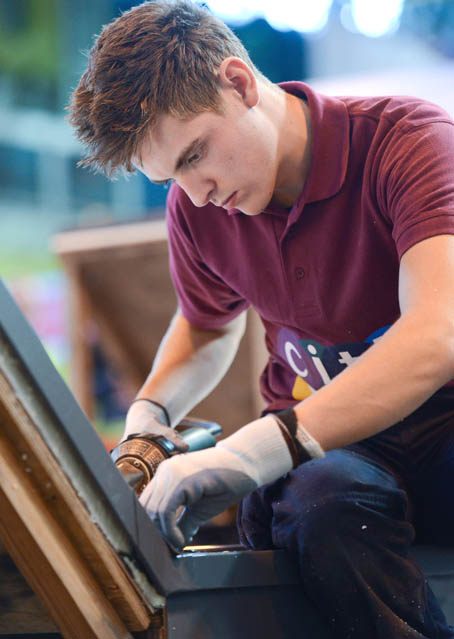Quality in Flat Roofing: Sharing What We Know
David Maginnis and Tony Lawther were invited to present a case study on behalf of BriggsAmasco at the RIBAJ Morning Seminar: Quality in Flat Roofing – Sharing What We Know, a joint enterprise between the RIBA Journal and SIG Design & Technology.
The seminar took place on 23rd November 2016 at the Building Centre in London, WC1 and was attended by around 60 delegates, mainly architects.
The BriggsAmasco presentation centred on our experiences during one of the largest and most challenging projects to take place during the recession – the refurbishment of the 1960s Birmingham New Street Station.
Between April 2012 and September 2015, we installed 7 different roofing systems over an area of 18,005m², with 97% of materials sourced from the UK. Alongside our existing employees, we recruited specifically for this project and at its peak had 50 staff and trades people working on site. We provided training, with 720 hours being achieved overall in conjunction with BGP.
Apart from the challenges of design and logistics, the station had to remain fully operational whilst the integration of new and old structures took place, which was a huge challenge for all concerned.
The seminar closed with a Q&A panel where Dave, Tony and the other presenters responded to a variety of questions from the delegates
Double award for our Scottish branches
Both our branches in Scotland have picked up the following awards at the NFRC Scottish Roofing Contractor of the Year Awards 2016 held The Grand Central Hotel, Glasgow on 4 November.
- Glasgow for the Reinforced Bituminous Membrane category at Edinburgh Airport
- Aberdeen for the Green Roof category at Kingsbarns
Pictured with TV Presenter Hazel Irvine, left, Raymond Wright (Manager of Glasgow branch) and right, Steve Adams (Manager of Aberdeen branch).
Team GB wins at the IFD World Championship
Creativity, initiative and collaboration win coveted international award for young roofers
Ben Revitt of our Birmingham branch represented the UK in the World Championships for Young Roofers in Warsaw last month, with Jordan Lane of Lane Roofing. They were mentored by Gary Walpole, SPRA Training Manager.
Using their own creativity and initiative with a range of roofing products, the duo worked together to win the prestigious President’s Prize for Innovation in the waterproofing category.
The three day Championships are organised by the International Federation of Roofing Contractors (IFD) and attract competitors from around the world. They are aimed at creating a common international message to promote the standards of skilled young roofers, raise the profile of on the job training and increase respect for the technical skills required in the roofing trade. Four young roofers formed Team GB to represent waterproofing and pitched roofing disciplines.
BriggsAmasco was proud to sponsor the UK entry and as Livia Williams, head of training at the NFRC, said in the RCI, “We couldn’t be more proud of Team GB’s performance. Our young roofers displayed an exceptional level of skill, workmanship and pride in their work over the three days, and at such a high standard, it was no easy task for the judges to decide.”


Further reading can also be found on the rci website.
NFRC Scottish Roofing Contractor of the Year Awards 2016
Our branches in Scotland have been shortlisted for the following awards.
- Reinforced Bituminous Membrane – Edinburgh Airport
- Liquid Applied Waterproofing – Capitol Theatre
- Green Roof – Kingsbarns
The winners will be announced the awards luncheon being held on 4 November at The Grand Central Hotel, Glasgow.
New Street Station wins UK Project of the Year
The redevelopment of Birmingham’s New Street station has won the overall prize at the Royal Institution of Chartered Surveyors (RICS) Awards. Further reading can be found on the Business Quarter website.
BriggsAmasco was appointed by Mace to install approximately 15,000m2 of waterproofing. Over 38,000 of man hours was completed on-site, including working 24/7 and taking deliveries overnight to avoid disruption during the day. You can read the full case study here.
Collaboration In the Supply Chain
John Linsdell, General Manager of BA Consult, took to the Main Stage at the NEC as a panellist discussing collaboration within the commercial construction supply chain on 18th October, the first day of UK Construction Week 2016.
The panel had a bias towards the early stages of a project with architects and professional standard setting bodies forming the majority of the panel.
John brought a “real life” edge to the discussion citing his early involvement in the Building Down Barriers project in the late 1990s as a first step towards collaboration within the construction industry.
Barriers to collaboration were debated, including tender awards being made on cost rather than quality of supply chain, and trust being a difficult barrier to overcome.
A brief discussion on BIM was held as a good example of the whole construction industry working collaboratively together, although it still has some way to go.
Each panellist was then asked to give a real life illustration of collaboration and John gave the only example explaining how, when work on the British Museum was announced as entirely accident free, a celebration get together was held. The interesting thing was that operatives from all trades, seemed to know and get on with each other; collaboration as a natural occurrence of working alongside each other on site.
Much of the discussion focussed on collaboration being led “top down” and this is absolutely essential. Maybe, though there is also something to be learnt from the British Museum example of “ground roots” level collaboration.
As John said, “Everyone needs to buy in and work together.






